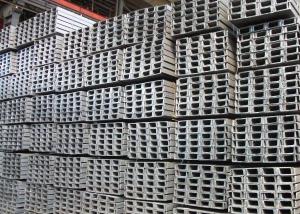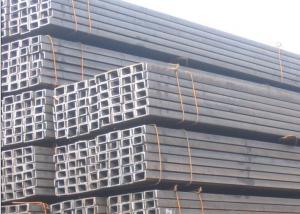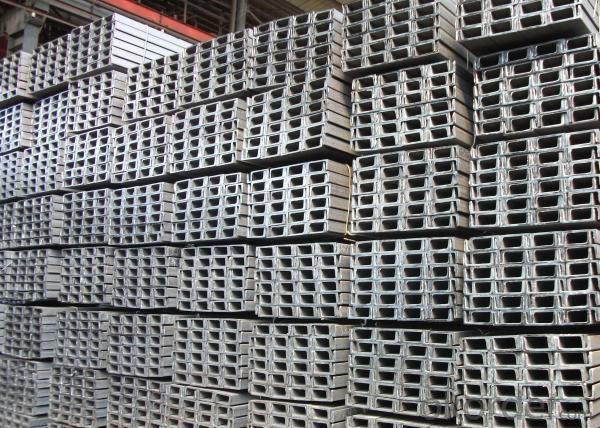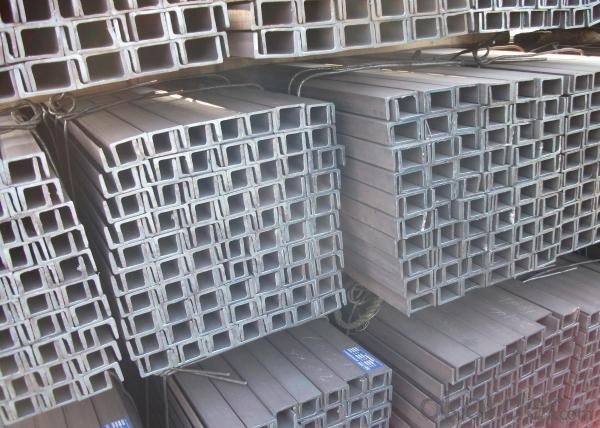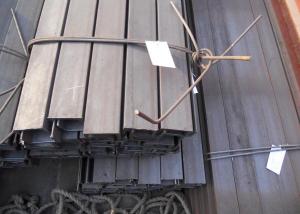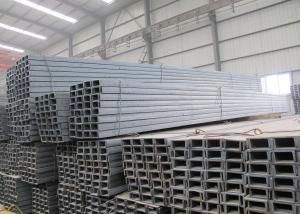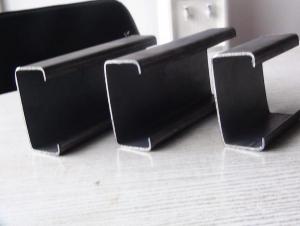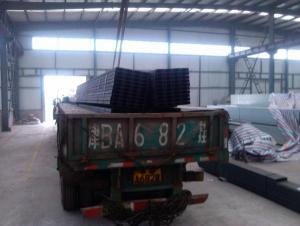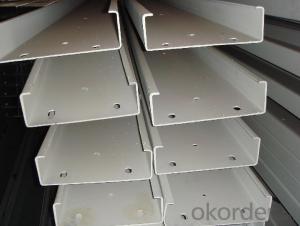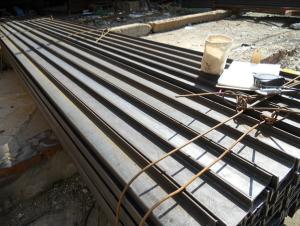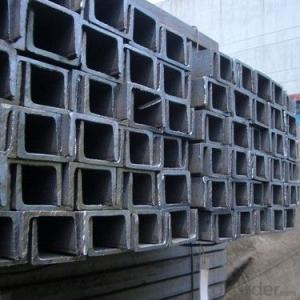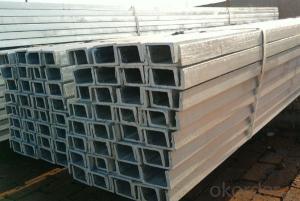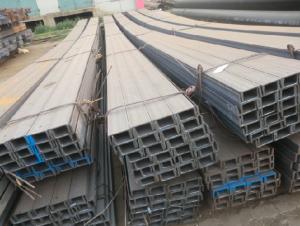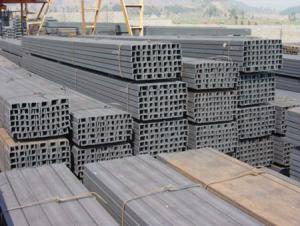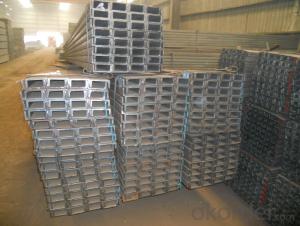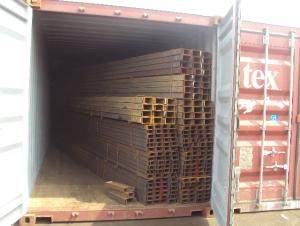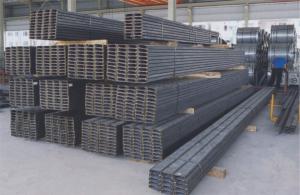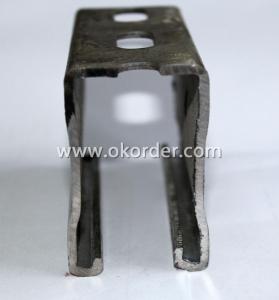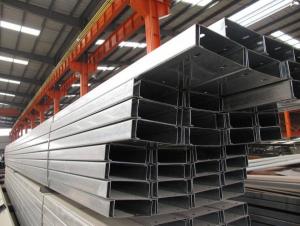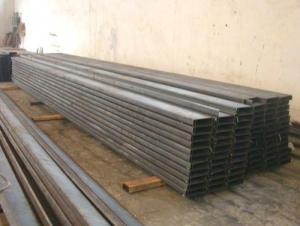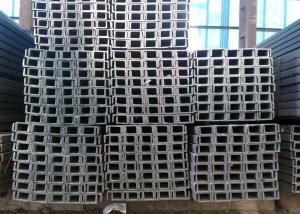Channel Steel
- Loading Port:
- Xingang Port
- Payment Terms:
- TT or LC
- Min Order Qty:
- 25 m.t.
- Supply Capability:
- 80000MTS/YEAR m.t./month
OKorder Service Pledge
OKorder Financial Service
You Might Also Like
Specifications of Channel Steel:
| Original Place | Tangshan, China | Brand Name | Bridge |
| Standard | GB707-88, EN100025, JIS G3192, DIN 1026 | ||
| Sizes | 50mm to 300mm | ||
| Sales Volume/Year | 3000MT | ||
| Main Market | Middle East, Africa, Southeast As | ||
1.We are able to provide channel steel of top quality at attractive price.
2.Our products of channel steel have passed ISO9001:2008 Quality Management System Certification.
3. The section of JIS Standard Channel Steel are as followings in the table.
| JIS U CHANNEL | Standard
h |
Sectional
b |
Dimension
s |
t |
Mass:
Kg/m |
| (mm) | (mm) | (mm) | (mm) | ||
| 50x25 | 50 | 25 | 3.0 | 6.00 | 2.37 |
| 75X40 | 75 | 40 | 3.8 | 7.00 | 5.30 |
| 75X40 | 75 | 40 | 4.0 | 7.00 | 5.60 |
| 75X40 | 75 | 40 | 4.5 | 7.00 | 5.85 |
| 75X40 | 75 | 40 | 5.0 | 7.00 | 6.92 |
| 100X50 | 100 | 50 | 3.8 | 6.00 | 7.30 |
| 100X50 | 100 | 50 | 4.2 | 6.00 | 8.03 |
| 100X50 | 100 | 50 | 4.5 | 7.50 | 8.97 |
| 100X50 | 100 | 50 | 5.0 | 7.50 | 9.36 |
| 125X65 | 125 | 65 | 5.2 | 6.80 | 11.66 |
| 125X65 | 125 | 65 | 5.3 | 6.80 | 12.17 |
| 125X65 | 125 | 65 | 5.5 | 8.00 | 12.91 |
| 125X65 | 125 | 65 | 6.0 | 8.00 | 13.40 |
| 150x75 | 150 | 75 | 5.5 | 7.30 | 14.66 |
| 150x75 | 150 | 75 | 5.7 | 10.00 | 16.71 |
| 150x75 | 150 | 75 | 6.0 | 10.00 | 17.90 |
| 150x75 | 150 | 75 | 6.5 | 10.00 | 18.60 |
4. Chemical Compostion of JIS Standard Channel Steel
| Grade | Element(%) | |||
| C | Mn | P | S | |
| SS330 | -- | -- | ≦0.050 | ≦0.050 |
| SS400 | ||||
| SS490 | ||||
| SS540 | ≦0.30 | ≦1.60 | ≦0.040 | ≦0.040 |
Usage/Applications of Channel Steel:
Channel Steel is usually used for building structure, vehicle manufacturing and other industrial structure and often used with i beam.
In details, the channel steel belongs to carbon structural steel which is applied to in the field of construction and machinery. The channel steel is usually used for arch-itechtural structure, and they could be welded in order to support or hang a vari-ety of facilities. They are also usually used in combination with I beam. Generally,the channel steel must possess perfect welding property, riveting property and mechanical property and so on.
Package & Delivery of Channel Steel:
The steel u channel will be packed in bundle with steel wire at each end of every bundle and color marking in order to help the customer to recognize his goods more easily at sight.
And steel u channel could be loaded into 20ft or 40ft container, or by bulk cargo. If the weight of each bundle reaches less than 3.5 mt, the loading by break bulk cargo should be choosed. When the weight of each bundle reaches less than 3mt, the loading by container should be choosed.
As for the transportaion from mill to loading port, the truck will be usually used. And the maximum quantity for each truck is 40mt.
All in all, we could do in accordance with customer's request.
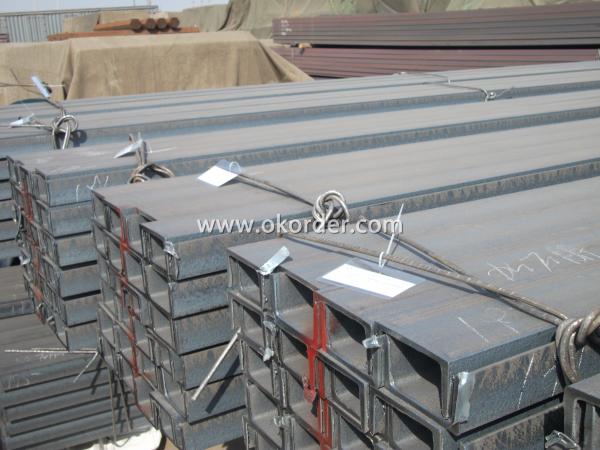
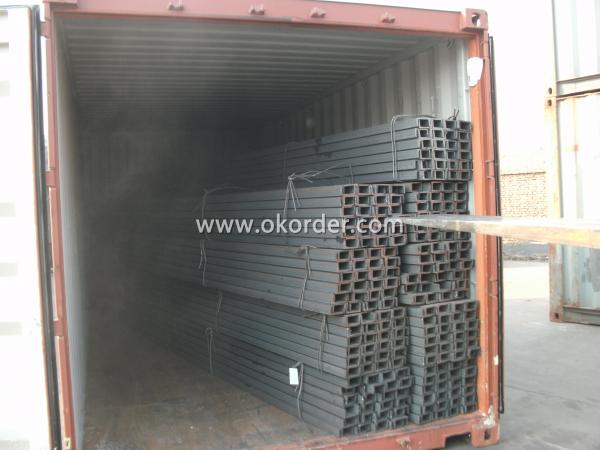
Production Flow of Channel Steel:
1.The steel billet shall be heated in the high temperature furnace.
2. The heated steel billet shall be rolled five to nine times with the aim of shaping the general figure of steel u channel.
3. The rolled steel u channel should be put onto the cooling bed to make the temperature low.
4. The steel u channel should be straighted on the straightener.
5. The straighted steel u channel will be cut into meters by saw, as per customer's requirements.
- Q: Are steel channels suitable for railway tracks?
- Railway tracks cannot be constructed using steel channels. Instead, a specialized type of steel rail is required for withstanding the immense weight and continuous usage of trains. Steel channels are typically utilized in construction for providing structural support and lack the necessary strength and durability to serve as railway tracks. Moreover, they do not possess the required shape and design features, including the appropriate rail profile and fastening system, necessary for ensuring the safety and efficiency of railway operations. Consequently, it is imperative to employ dedicated steel rails that are specifically designed for railway tracks to guarantee the functionality and safety of the railway system.
- Q: The telescopic arm is welded by channel steel and steel plate. Then the channel steel is inclined and the guide is not good enough. Is it a special profile? What are the telescopic arms?
- As for the welding standards, it is difficult to say, because this practice itself is a non-standard, it is difficult to have national standards, industry standards, and even enterprise standards
- Q: Can steel channels be used in water treatment plants?
- Indeed, water treatment plants can make use of steel channels. The utilization of steel in water treatment plants is widespread owing to its resilience, robustness, and resistance to corrosion. Steel channels can serve multiple functions such as equipment support, walkway creation, and provision of structural support for pipelines and conduits. Nevertheless, it is crucial to take into account the precise requirements and conditions of the water treatment plant, including the type of water being treated and any potential chemical or environmental factors that could impact the steel channels. Applying a suitable coating or protection may be necessary to prevent corrosion and ensure the prolonged lifespan of the steel channels in the water treatment plant setting.
- Q: Can steel channels be used in interior design applications?
- Certainly, interior design applications can make use of steel channels. With their versatility and durability, steel channels prove to be fitting for various design purposes. They can serve as structural elements, decorative accents, or even functional features within interior spaces. Architectural details, including room dividers, wall paneling, shelving units, and furniture pieces, can creatively incorporate steel channels. By doing so, they lend an industrial and contemporary touch to any interior design style, thanks to their sleek and modern appearance. Moreover, steel channels offer flexibility to interior designers as they can be customized in terms of size, finish, and shape, thus meeting specific design requirements.
- Q: Can steel channels be used in bridges and flyovers?
- Yes, steel channels can be used in bridges and flyovers. Steel channels are commonly utilized in the construction of bridges and flyovers due to their high strength and durability. They provide structural support and stability, making them ideal for such infrastructure projects.
- Q: What are the standard sizes of steel channels?
- Steel channels come in a variety of standard sizes, which depend on the region and industry standards being followed. These sizes are designed to meet the different requirements of construction and engineering projects. Examples of common standard sizes include C3x4.1, C6x8.2, C8x11.5, C10x15.3, C12x20.7, C15x33.9, C18x54.7, C20x66.3, and so on. These sizes indicate the dimensions of the channel, such as its height, width, and weight per foot. It's worth noting that there might be slight variations in these sizes depending on the manufacturer or supplier. Therefore, it is advisable to refer to relevant industry standards or seek guidance from a professional engineer to determine the appropriate size of steel channels for a specific application.
- Q: Can steel channels be used in seismic design?
- Yes, steel channels can be used in seismic design. Steel channels, also known as steel C channels or C beams, are commonly used in seismic design due to their strength, stability, and ductility. In seismic design, the goal is to ensure that structures can withstand the forces generated during an earthquake. Steel channels are often used as structural members in seismic-resistant building systems due to their ability to absorb and dissipate energy. They have high load-carrying capacity, excellent bending and torsional resistance, and can effectively resist lateral forces caused by seismic activity. Additionally, steel channels can be designed and fabricated to meet specific seismic design requirements, such as using thicker steel plates or adding additional reinforcement. Overall, steel channels are a versatile and reliable choice for seismic design applications.
- Q: Can steel channels be used in the construction of bridges?
- Yes, steel channels can be used in the construction of bridges. Steel channels are structural components that offer high strength and stiffness, making them suitable for bridge construction. They are frequently used to create the framework and supports for bridges, providing stability and load-bearing capabilities. Steel channels are versatile and can be fabricated into various shapes and sizes, allowing for flexibility in bridge design. Additionally, steel is a durable and long-lasting material that can withstand heavy loads, weather conditions, and environmental factors, making it an ideal choice for bridge construction. Overall, steel channels are commonly used in bridge construction due to their strength, versatility, and durability.
- Q: Can steel channels be used for overhead crane support?
- Yes, steel channels can be used for overhead crane support. Steel channels are commonly used in construction and engineering applications due to their strength and durability. They provide a rigid and stable structure that can support heavy loads, making them suitable for supporting overhead cranes. Steel channels can be designed and installed in various configurations to meet the specific requirements of the crane system, ensuring safe and reliable operation.
- Q: How do steel channels perform under earthquake loads?
- Steel channels are known for their excellent strength and ductility, which allows them to perform well under earthquake loads. The structural integrity and stiffness of steel channels help to effectively resist seismic forces and minimize damage. They can absorb and distribute the energy generated during an earthquake, reducing the chances of collapse or failure. Additionally, steel channels can be designed and reinforced to withstand specific seismic conditions, making them a reliable choice for earthquake-resistant structures.
1. Manufacturer Overview
| Location | Hebei, China |
| Year Established | 1993 |
| Annual Output Value | Above US$100 Million |
| Main Markets | South Asia Middle East; Southeast Aisa; south Korea |
| Company Certifications | ISO 9001:2000 |
2. Manufacturer Certificates
| a) Certification Name | |
| Range | |
| Reference | |
| Validity Period |
3. Manufacturer Capability
| a) Trade Capacity | |
| Nearest Port | Tianjin; |
| Export Percentage | 1% - 10% |
| No.of Employees in Trade Department | 11-20 People |
| Language Spoken: | English; Chinese |
| b) Factory Information | |
| Factory Size: | Above 20,000 square meters |
| No. of Production Lines | 1 |
| Contract Manufacturing | OEM service offered |
| Product Price Range | average |
Send your message to us
Channel Steel
- Loading Port:
- Xingang Port
- Payment Terms:
- TT or LC
- Min Order Qty:
- 25 m.t.
- Supply Capability:
- 80000MTS/YEAR m.t./month
OKorder Service Pledge
OKorder Financial Service
Similar products
Hot products
Hot Searches
Related keywords
